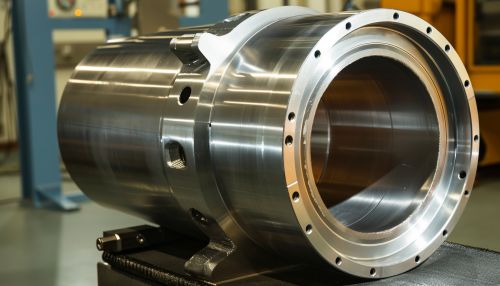Radio-frequency cavity
Introduction
A radio-frequency (RF) cavity is a metallic, enclosed structure that is used to confine and manipulate radio-frequency electromagnetic fields. These cavities are key components in a variety of applications, including particle accelerators, microwave devices, and telecommunications systems.
Structure and Function
An RF cavity is typically constructed from a conductive material such as copper or aluminium. The interior of the cavity is hollow, and its shape and size are carefully designed to resonate at a specific frequency or range of frequencies. When an electromagnetic field is introduced into the cavity, it bounces back and forth between the walls, creating a standing wave pattern. This resonant behavior allows the RF cavity to store and concentrate energy, which can then be used to accelerate charged particles or to generate and amplify microwave signals.
Applications
Particle Accelerators
In particle accelerators, RF cavities are used to accelerate charged particles to high speeds. The particles are injected into the cavity, where they are exposed to the resonant electromagnetic field. This field imparts energy to the particles, causing them to accelerate. By arranging multiple RF cavities in a sequence, it is possible to achieve very high particle energies. This principle is used in large-scale accelerators such as the Large Hadron Collider.
Microwave Devices
RF cavities also play a crucial role in the generation and amplification of microwave signals. In a magnetron, for example, a cylindrical RF cavity is used to generate high-power microwave radiation. This is achieved by injecting a stream of electrons into the cavity, where they interact with the resonant electromagnetic field to produce microwave radiation. This principle is used in a variety of applications, from radar systems to microwave ovens.
Telecommunications
In telecommunications, RF cavities are used in devices such as cavity filters and cavity resonators. These devices exploit the resonant properties of RF cavities to select or amplify signals at specific frequencies. This makes them invaluable tools for filtering and shaping the radio-frequency signals that carry our voice and data communications.


Design and Optimization
The performance of an RF cavity is heavily dependent on its design. The shape and size of the cavity, the material from which it is made, and the frequency at which it is operated all have a significant impact on its resonant behavior and energy storage capacity. As such, the design and optimization of RF cavities is a complex task that requires a deep understanding of electromagnetism and materials science.
One of the key considerations in RF cavity design is the quality factor, or Q-factor, which is a measure of the energy loss within the cavity. A high Q-factor indicates low energy loss, which is desirable for applications such as particle accelerators where efficiency is paramount. The Q-factor can be increased by using highly conductive materials and by optimizing the shape of the cavity to minimize electromagnetic field distortions.
Another important consideration is the resonance frequency, which determines the frequency at which the cavity can store and release energy. The resonance frequency is primarily determined by the size and shape of the cavity, and it must be carefully matched to the frequency of the input signal for efficient operation.
Future Developments
As our technological capabilities continue to advance, so too does the complexity and performance of RF cavities. One area of active research is the development of superconducting RF cavities, which offer significantly higher Q-factors than their conventional counterparts. These cavities are made from superconducting materials, which exhibit zero electrical resistance at low temperatures. This allows them to store and release energy with near-perfect efficiency, making them an attractive option for next-generation particle accelerators and microwave devices.
